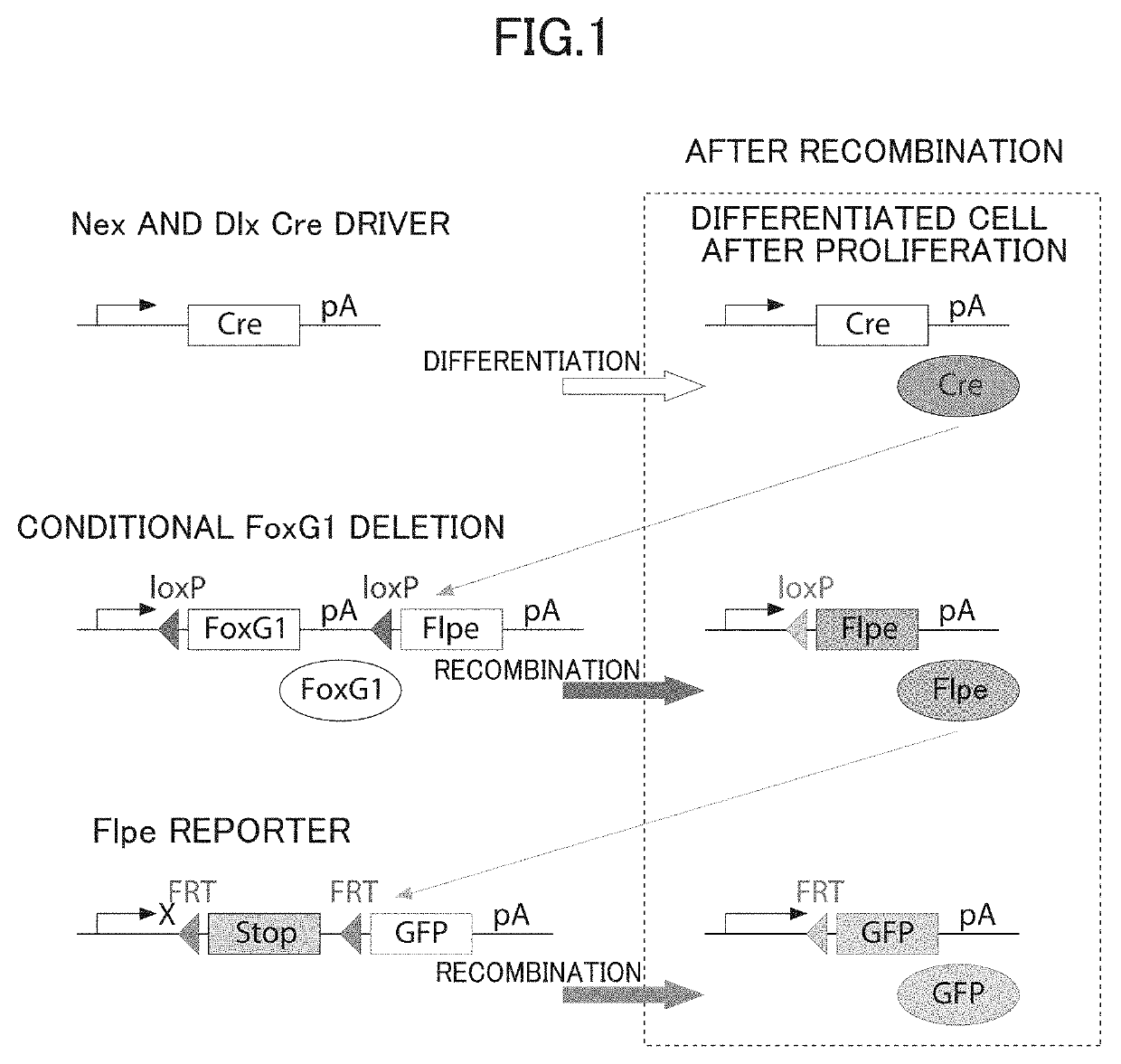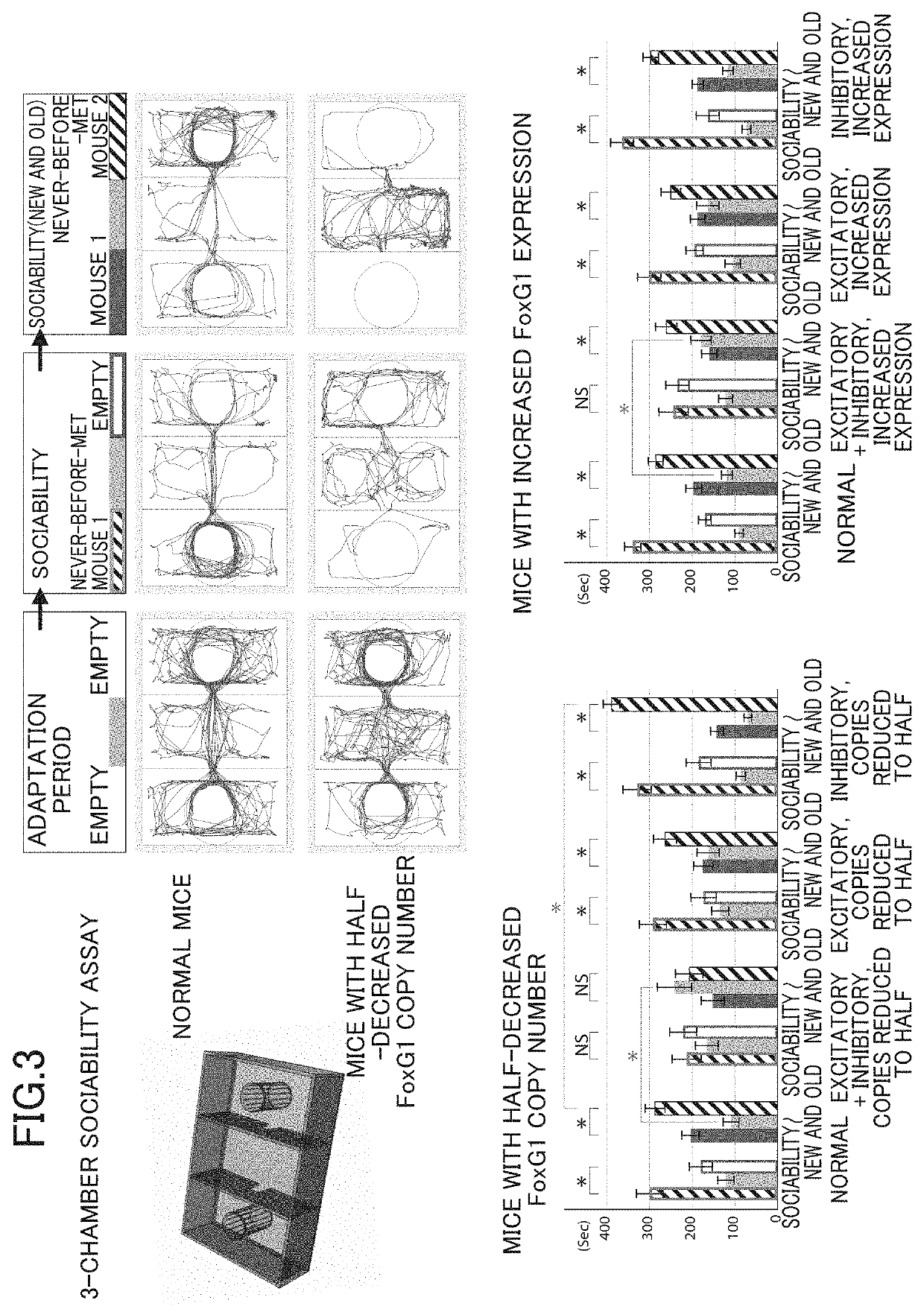Rodent models with autistic features
a technology of autistic traits and rodents, applied in the field of rodents exhibiting autistic characteristics, can solve the problem that no model animals have been developed
- Summary
- Abstract
- Description
- Claims
- Application Information
AI Technical Summary
Benefits of technology
Problems solved by technology
Method used
Image
Examples
example 1
[0085]Example 1 applied a known conditional knock-out operation (Dev Cell. 2004 January; 6(1): 7-28) to a mouse to prepare an autistic mouse subjected to the “operation of decreasing the number of copies of a FoxG1 gene in both differentiated excitatory neurons and differentiated inhibitory neurons present in a brain from two copies to one copy.”
(1) Transgenic Animal A
[0086]The transgenic animal A (female) was prepared from a mouse (trade name: floxed-FoxG1, source: New York university) in accordance with the method described in the literature (Neuron. 2012 Jun. 21; 74(6): 1045-58).
[0087]The transgenic animal A carried two copies of the FoxG1 gene inserted with loxP sequences at both ends, and was further inserted with the Flpe gene in further downstream of the loxP sequence on the downstream side of the FoxG1 gene of each copy.
[0088]The sequence of the FoxG1 gene was the sequence registered on GenBank with an accession number of “NM_001160112.”
[0089]The loxP sequence was the sequen...
example 2
[0110]Example 2 prepared an autistic mouse by “performing, seven or more days after birth, an operation of increasing expression levels of a FoxG1 gene in both differentiated excitatory neurons and differentiated inhibitory neurons present in a brain to 1.2 to 2.0 times that of a wild type animal.”
(1) Transgenic Animal C
[0111]The R26-stop-tTA animal used was a commercially available mouse (Jackson mouse Stock No: 008600 Gt(ROSA)26Sortml(tTA)Roos CURL: https: / / www.jax.org / strain / 008600), The Jackson Laboratory).
[0112]The TRE-FoxG1 animal (mouse) was prepared in accordance with the method described in the literature (J Neurosci. 2002 Aug. 1; 22(15): 6526-36).
[0113]The R26-stop-tTA mouse and the TRE-FoxG1 mouse were crossed to obtain eight mice, and the eight mice were further crossed to select by the genotyping method the transgenic animal C carrying by homozygosity two copies each of R26-stop-tTA and TRE-FoxG1.
[0114]The sequence of the R26 locus was the sequence registered on GenBank...
PUM
| Property | Measurement | Unit |
|---|---|---|
| Mental Disorders | aaaaa | aaaaa |
| period of time | aaaaa | aaaaa |
| time | aaaaa | aaaaa |
Abstract
Description
Claims
Application Information
 Login to View More
Login to View More - R&D
- Intellectual Property
- Life Sciences
- Materials
- Tech Scout
- Unparalleled Data Quality
- Higher Quality Content
- 60% Fewer Hallucinations
Browse by: Latest US Patents, China's latest patents, Technical Efficacy Thesaurus, Application Domain, Technology Topic, Popular Technical Reports.
© 2025 PatSnap. All rights reserved.Legal|Privacy policy|Modern Slavery Act Transparency Statement|Sitemap|About US| Contact US: help@patsnap.com



